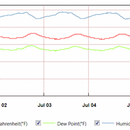Vented Crawlspace Humidity
Where can I go for good, local, information on crawl space humidity issues?
Attached is a recording from a crawlspace in zip code 94705. It’s a vented mostly dirt crawlspace with 6 mil plastic covering everything, without taped seams or edges. The humidity is well above what most Internet sources say is ideal for a basement, but well below the average humidity of the outside air. The area has frequent foggy mornings and evenings, but mild temperatures all year.
A contractor has recommended a timer based crawlspace ventilation system, but this seems like it might increase rather than decrease humidity – especially on a foggy day when literally it can feel like it is misty out. Thoughts?
GBA Detail Library
A collection of one thousand construction details organized by climate and house part










Replies
Bryce,
Is there any indication that the humidity is causing problems?
I'm sitting at a desk with all the windows open. It's sunny out and the humidity in my living room is tracking the outside at 65%. If it got that high in the rainy winter season I'd be more worried.
How old is the building?
Are thing rotting and moldy?
If the building is old and survived without problem the smart move is not go and change stuff.
Vented crawlspaces have been around forever and work fine they do use more BTUs per square foot.
Walta
I got more details.
The current house on that lot was built 1995.
It did develop mold in a back bedroom and visibly on the floor trusses.
It turns out the above humidity readings are with a timer based fan going 5-6 hours per day.
The plastic sheeting and fan were apparently the solution implemented about 15 years ago to remedy the observed mold. The mold reportedly has not reappeared and the basement feels dry, not musty.
There is no underfloor insulation, the floors above are hardwood.
--
So I guess the options are leave it, replace the timer with a delta humidity sensor, or turn off the fans and see how it goes. That brings up again the question of what defines sucecss.
--
What's "normal" for a vented dirt crawl in this area? How would I determine for a given area of the country what range is safe, worrysome or deadly?
Or, as part of an energy upgrade, seal the crawl vents and tighten up the ground level vapor barrier. This area has no radon issues.
Bryce,
If you go that route, an approach which most here would recommend, you will need to condition the space by either connecting it to the house above with vents, or doing so mechanically.
Do you have mild climate references for that? Depressurizing the sealed crawl to draw dry house air down is fine... I'd be hesitant to allow any new reverse flow from crawl to house.
But again what's "normal" other than "no mold". Is there a way to measure the humidity and gauge how OK or not a given basement is with vents?
I see this, but without much in the way of climate specific details https://www.energystar.gov/sites/default/files/asset/document/Designing%20Closed%20Crawlspaces.pdf
Some attempts at a clear diagram, from Nachi
https://forum.nachi.org/t/conditioned-crawlspace-graphic/202056
You could consider taking moisture content readings of various components (wood sills, etc.) throughout a year or so. And of course keeping an eye out for mold development.
+1 on not fixing what isn't broken. But if you had to install a fan, ideally it would be controlled by outdoor vs crawlspace dew point.